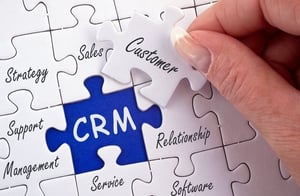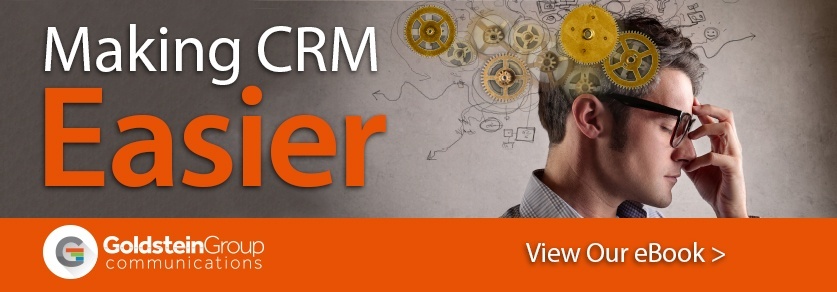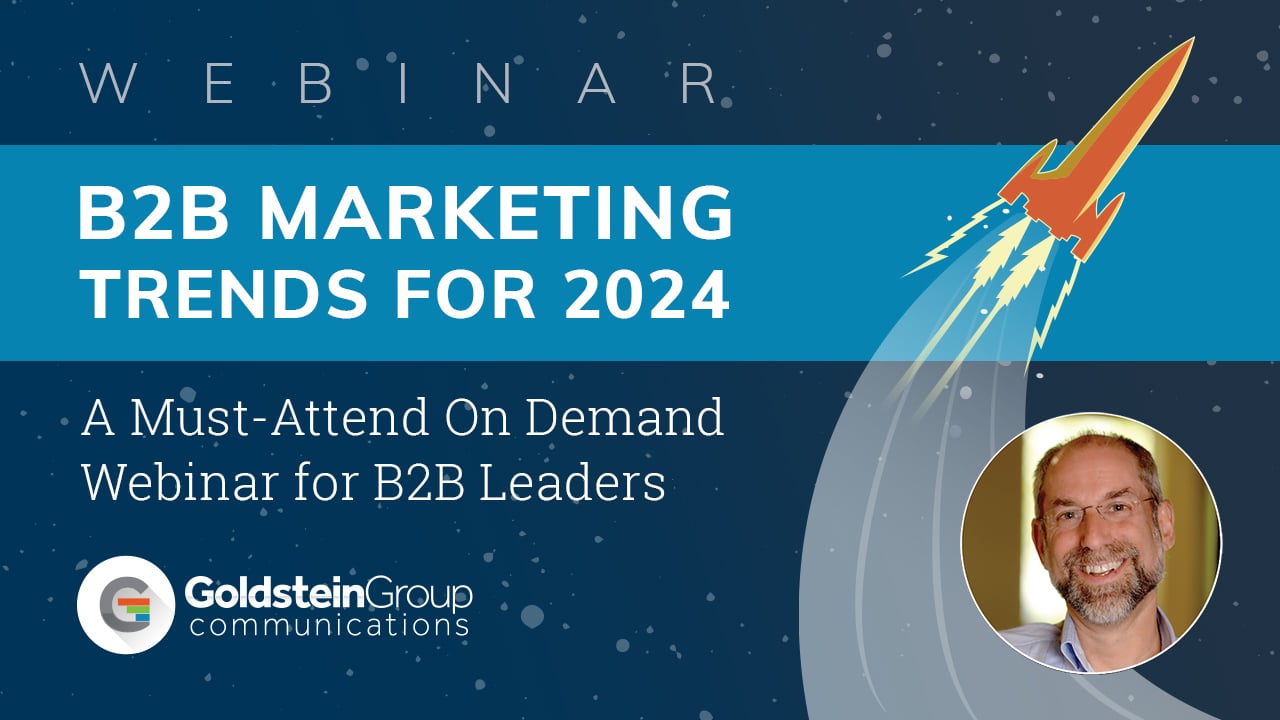Why is CRM So Hard?
Why is CRM So Hard?
 Sales Enablement is all the rage these days. The concept of getting more traction in sales and more alignment between sales and marketing is certainly not new. However, the spotlight on finally eliminating the barriers between sales and marketing is getting more attention than I’ve ever seen in 35 years of b-to-b marketing.
Sales Enablement is all the rage these days. The concept of getting more traction in sales and more alignment between sales and marketing is certainly not new. However, the spotlight on finally eliminating the barriers between sales and marketing is getting more attention than I’ve ever seen in 35 years of b-to-b marketing.
Much of the focus is on optimizing CRM systems and processes, and integrating them with marketing lead gen tools and programs. But it’s curious, isn’t it? Why is CRM such a struggle for companies? Why do most studies say that 50% of CRM installations and projects fail? Why does Google report, in this day and age, that 27,000 people still search every month on the term “what is CRM?”
Why do CEOs accept this?
But here’s the biggest question in my mind: why do company CEOs and Sales VPs accept such low success rates – and low CRM user adoption from their salespeople? Why do CEOs seem so ready to accept uneven adoption in their sales process, when they would NEVER accept such inefficiency in their accounting or manufacturing operations?
Understanding the answer to that is essential before any Sales Enablement initiative can be successful, and to make sure it doesn’t join the long, sad list of failed CRM projects. Just integrating software tools won’t solve the problem. Having a marketing and sales “alignment” summit or workshop doesn’t seem to be the key to sustained, long-term success. A harsh “you-will-do-this-or-be-fired” email from your CEO is hardly the approach to generate enthusiastic adoption that will last – especially among those Millennial salespeople we’re hiring more often these days.
Understanding the root cause of resistance
It’s true that any initiative must tackle all three components of the project – People-Process-Technology – if Sales Enablement is to take hold. But understanding the root cause of resistance is important for us all to grasp if we’re going to see sales enablement results. So, again, just why is it that CRM success is so hard to achieve?
That roadblock became obvious to us when we began to engage with clients to improve their CRM and sales ops programs. It became instantly clear that it just wasn’t a priority for them or an area that deserved more spending. They certainly wanted more leads. They certainly wanted more SQLs, or Sales Qualified Opportunities. But tracking the sales pipeline or funnel management for their people? That was the very definition of a “nice-to-have” and far removed from a “have-to-have” priority for them.
To try to uncover an answer, we conducted a variety of “Trigger Interviews,” one-on-one conversations with CEOs, Sales VPs and even one former Salesforce Consultant. We apply these Trigger Interviews for clients when they’re launching a new product or message, to understand the triggers that get people to buy a product from them or a competitor. So we applied it to our own work: what gets you as a CEO or sales leader to buy and apply CRM-Sales Traction services, or not, for your organization?
It’s amazing what you learn when you just sit back and listen.
Solving the six barriers to CRM adoption
CRM adoption, we’ve learned, will finally increase by solving six barriers:
- CRM tools are hard to use and the processes are time-consuming. Most sales teams have had at least one or two experiences launching a CRM, and depending on what they’ve tried, the tools often are hard to use or built on a cumbersome, time-consuming process. At the end of the day, Steve Jobs was right: uber-simplicity is what’s required for adoption. If it is hard to use or hard to understand, it won’t fly. And if the process is awkward and takes a lot of steps, it won’t be adopted.I heard someone ask once, “How fast do your salespeople type? Because that’s what you’re asking them to do for two hours a day instead of selling.”CRM will work if salespeople see that it makes their jobs easier and help them sell more. At the end of the day, that’s the only concept that will work. To them, everything else is just noise.
- CEOs are afraid of their salespeople. Many CEOs have bought into the myth that sales is somehow magical, a black box, not predictable. As long as Beth makes quota, I’m happy with that, they say. And I certainly don’t want to make her mad by asking her to use a CRM that she sees as busy-work. They understand that the contacts salespeople have in their heads and on their computers are a company asset, and that if the salesperson leaves, they take that asset with them. Yet they’re so reluctant to interfere with the “sales process” and relationships their people have that they allow themselves to be held hostage by their fear of doing anything to jeopardize sales results.
- Sales VPs (and many CEOs) are afraid of technology. Salespeople are typically social, engaging people. They’re not often thought of as analytical, or even comfortable with technology. Many told us during our Trigger interviews, and we’ve all certainly seen this, that the Sales leader never logs in to his or her CRM, or she has her sales admin do it. Others talked about how they just use Excel spreadsheets to manage sales and pipelines. We even heard one story about a sales exec who had his admin log in to Salesforce each week to export reports from Salesforce BACK INTO EXCEL before the Monday morning sales meeting!It makes perfect sense to account for this by relying on marketing people, who typically are more comfortable with analytics and data, to manage CRM as part of a larger Sales Enablement strategy.
- Sales teams don’t like the tracking and transparency that comes from CRM. Most salespeople don’t want to be accountable or tracked with forecasts and funnel reports. Why should they? It’s a much easier life to just make my quota without really reporting out all the data and activity that my manager wants to see, they say. Resolving this reluctance, or even simply addressing it with the sales team, will go a long way toward getting them to understand that transparency is a fact of life for today’s data-driven organizations.
- CRM doesn’t work for any of my CEO friends, so why should I expect it would work for my company? When CEOs network with their peers, they hear similar nightmare CRM adoption stories. It’s easier for them to accept that it’s difficult or out-of-reach and therefore settle for lack of adoption.
- CRM is a tool that brings predictability to your sales operation. CEOs would LOVE pipeline forecasting, but they don’t see realize that CRM can be used to provide that. They don’t see how CRM can be used to drive more sales with fewer resources, fewer days to close and therefore greater profitability. Slow sales is certainly a trigger for a CEO or Sales VP to make changes; however, our interviews indicated that connecting CRM adoption to accurate pipeline forecasting would be tremendously attractive to CEOs.
ROI remains the single most important priority for marketing executives today. Integrating marketing programs with sales results is the only way to see true ROI performance from our marketing programs, not just reporting on clicks or even lead flow. If we marketers want to crack this Sales Enablement concept, we HAVE to become more successful in driving CRM adoption and not rely on Sales VPs or even the CEO to make that happen.
It’s time to show our CEOs that we know how to apply the same lean principles they’ve embraced back in the manufacturing plant to one of the least efficient parts of the company. When they do, we’ll all finally be able to deliver what our core value as marketers: the ability to “Predict It. Control It. And Improve It.”
Learn more with our latest eBook on Solving the CRM Adoption Puzzle







